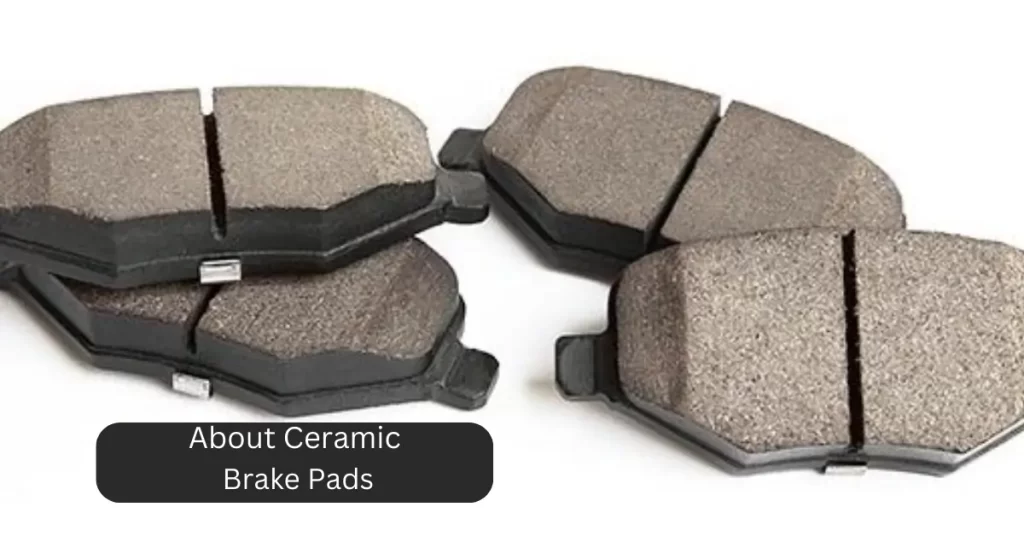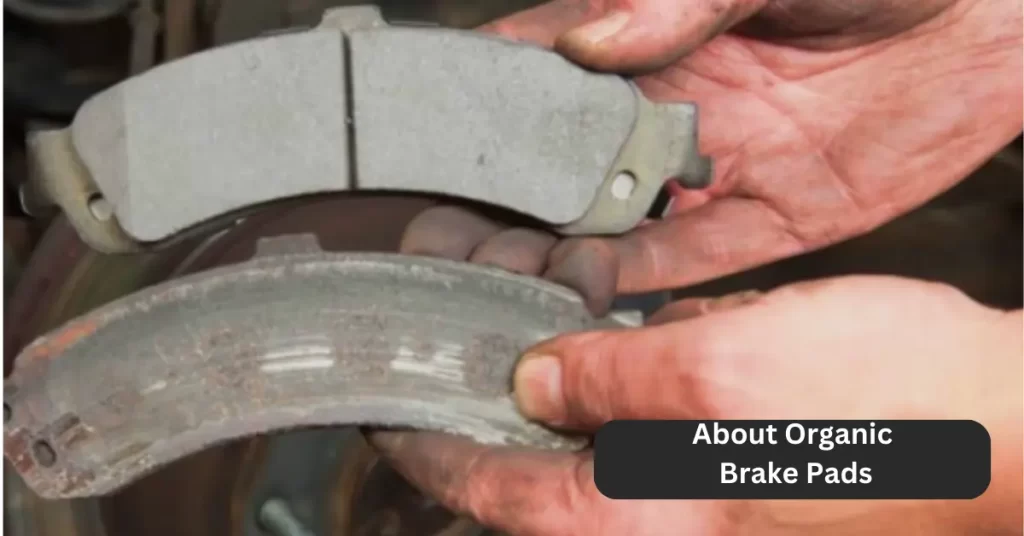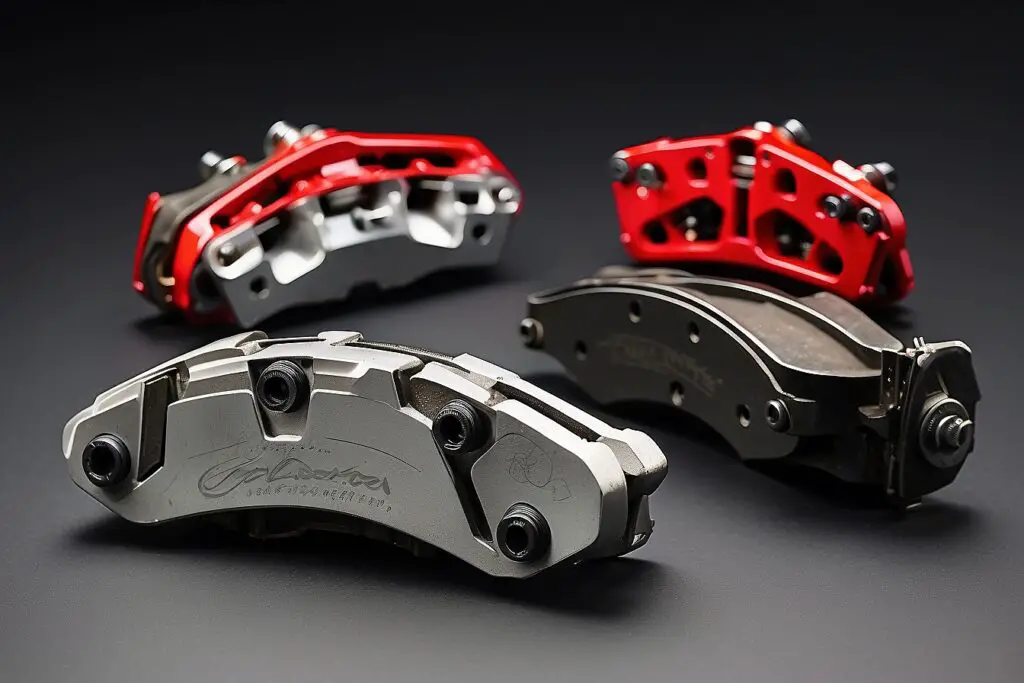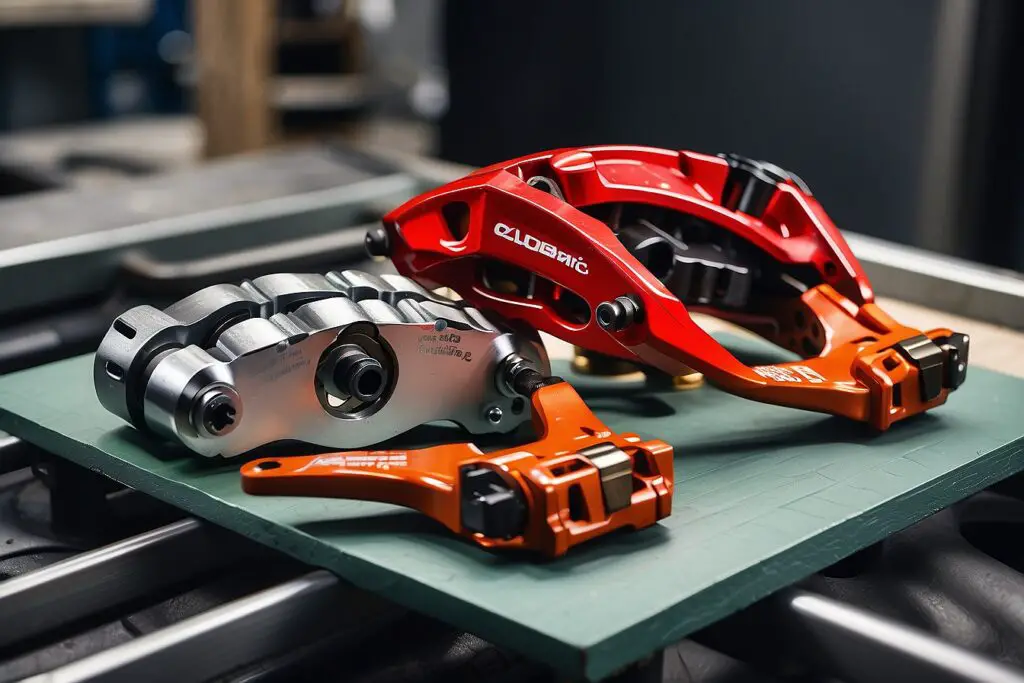Organic Brake Pads VS Ceramic Brake Pads: Pros And Cons
The brake system in your car is incredibly important for your safety on the road. When you press down on the brake pedal, pressure is distributed to your car’s brake lines and then sent to a caliper at each wheel, where it (potentially) interacts with a disc rotor. The force of the pressure pushes the brake pad against the rotor, creating friction that turns kinetic energy into thermal energy and eventually brings the wheels of your vehicle to a stop.
When considering which pad material is best for your braking system, it’s important to understand ceramic and metallic options. Ceramic pads are known for their quiet operation — they’re usually more durable than metallic alternatives and produce less dust while still providing good stopping power.
On the other hand, metallic brakes often offer a longer lifetime but come with loud screechings when you hit the brakes. Metallic pads tend to wear out quicker in high temperatures yet have higher resistance against fade due to heat build-up within the rotors. Both materials have advantages and disadvantages, so it’s ultimately up to you to decide which works best for your driving habits and lifestyle.
Table of Contents
A Brief History Of Brake Pads
Brake pads have been an essential component of the automotive industry for over a century. The first brake pads were made from organic materials such as asbestos, which provided a good friction surface but posed health risks due to the release of harmful fibers. In the 1980s, asbestos was gradually replaced with less hazardous materials like ceramic, semi-metallic, and non-asbestos organic (NAO) compounds.
These new materials improved braking performance and reduced health and environmental risks. Brake pads have also evolved in design, with the development of anti-lock braking systems (ABS) and electronic brake-force distribution (EBD) requiring more advanced pad formulations.
Additionally, advancements in manufacturing processes have also led to improved durability and longevity of brake pads. Today, brake pads are crucial for ensuring the safety and functionality of vehicles, and ongoing research and development continue to improve their performance and reduce their environmental impact.
About Ceramic Brake Pads

Ceramic brake pads are the perfect choice for people looking for long-lasting, reliable brakes. They are less abrasive on the rotor than their organic counterparts, which means they don’t get worn down as easily when applied.
While there is still some dust created by these pads, it is much lighter in color and doesn’t stick to your wheels as much. An added bonus to using ceramic brake pads is that their performance withstanding temperature changes is top-notch.
The downside of using ceramic brake pads is that they are much more expensive than organic versions. This may be a deterrent for those looking to find an economy-edition vehicle. But if you can budget it out and do your research into what kind of cars have this type of brake installed, then it could be a worthy investment down the road in terms of improved fuel efficiency and brake performance over time. Overall ceramic brakes are consistent, hardy, and long-lasting but at a higher price than others on the market.
Pros
The benefits of opting for ceramic brake pads are vast. One of the most notable advantages is their ability to produce quieter braking events. This emits a noise that is above the normal human range of hearing, making it much quieter than other options like organic or semi-metallic brakes.
Furthermore, as ceramic brake pads are less abrasive, they help reduce brake dust substantially compared to other models. This dust is usually lighter in color and unlikely to stick on wheels.
In addition, the lifecycle of ceramic brake pads tends to be longer than traditional organic or semi-metallic ones due to the compounds in their friction material.
While enduring high temperatures effectively without warping or fading, ceramic pads also dissipate heat efficiently to ensure their performance longevity further. All these factors make them an excellent option for any vehicle looking for a real break improvement in both sound and functioning.
Cons
One of the main drawbacks of ceramic brake pads is that they are usually the most expensive friction option. This can be a costly investment depending on the type and size of vehicle you own and its usage. Additionally, ceramic brake pads offer less bite than semi-metallic ones and are unsuitable for extremely cold climates.
Ceramic brake pads may also lead to higher braking system temperatures due to their lower heat absorbency than other friction materials. Therefore, these brakes are not recommended for severe-duty applications such as hauling that require greater pressure on the system to get the same stopping power as observed in regular driving conditions.
Moreover, using ceramic brake pads with low-quality rotors can also create excessive rotor wear. This is why it is essential to check and ensure all braking system parts are engineered to work together harmoniously for optimal results.
About Organic Brake Pads

Organic brake pads are becoming increasingly popular for a number of reasons. They are made from natural materials such as rubber and glass, making them softer and quieter than other brakes when you press down on the pedal. In addition, these brake pads are also budget-friendly and much more affordable for everyday car owners than ceramic or metal brake pads.
The best thing about organic brake pads is that they’re perfect for those who mostly drive around their local community rather than going on longer trips.
Plus, depending on the manufacturer, some organic brake pads can even add Kevlar to improve performance in wet conditions. Organic brake pads offer great value in terms of cost versus quality for passenger cars. It is not uncommon to find organic brakes installed in cars that need only short-distance driving.
Pros
Organic brake pads offer a great initial bite when braking. This offers the driver more control over slippery surfaces and excellent stopping capabilities. Furthermore, organic brake pads are generally much quieter than metallic ones, making them ideal for road noise concerns. On top of this, they do not create the same type of dust that is created by metallic pads. This makes them a very popular choice among those who observe strict vehicle maintenance measures.
Cons
On the other hand, organic brake pads tend to fade faster in comparison to ceramic or metallic options due to their softer nature. Additionally, organic brakes tend not to perform as well in wet conditions as these other brakes can better manage such weather. Long story short- if you’re looking for optimal performance, you should opt for a higher quality pad such as ceramic or metallic options.
Which is Better?
Ceramic brake pads are widely considered to be the better choice, offering durability and excellent performance compared to organic brake pads. These brakes are composed of a ceramic material, providing less dust, noise, and overall wear than their organic counterparts.
As long as they receive the proper maintenance, these forms of brakes will outperform organic brakes over time. However, they can come at a considerable cost as they are much more expensive than organic brake pads.
Organic brake pads also offer good results when properly managed but tend to produce more dust and degrade faster over time. While they frequently require more maintenance in order to prevent accelerated degradation due to heat build-up or sudden braking forces, these materials can provide a more affordable solution due to their lower price tag.
It all comes down to personal preferences; if you’re looking for an effective option at an economical price, organic brakes may be the right choice. Ultimately it is important that you consider the type of driving habits you have in combination with your economic state before making any final decisions on your brake pad selection.

Which Type of Brake Pads Should You Choose?
The type of brake pads you choose depends on your driving style and your vehicle’s needs. If you are looking for a cost-effective option and do not engage in aggressive driving, organic brake pads may be the right choice for you. However, if you want superior performance and are willing to pay a premium, ceramic brake pads may be the best option.
It’s important to note that while ceramic brake pads are more expensive, they can save you money in the long run by lasting longer and reducing the need for frequent replacements. Additionally, ceramic brake pads can help prevent rotor warping and reduce brake fade, which can be important factors for high-performance or heavy-duty vehicles.
Brake Pads: When to Change
Brake pads are an essential component of any vehicle’s braking system. Over time, they wear down due to the friction and heat generated during braking. It is important to regularly inspect your brake pads to ensure they are still in good condition. However, there are some tell-tale signs that indicate it’s time to change your brake pads.
If you notice a high-pitched squealing noise when applying the brakes, this could be a sign that the brake pads are worn down. Another indicator is if you feel a pulsating or vibrating sensation when braking, as this could mean the brake pads are no longer making solid contact with the rotor.
Additionally, if you notice that it takes longer for your vehicle to come to a complete stop, it may be time to replace your brake pads. It is critical to replace worn brake pads promptly to maintain the safety and performance of your vehicle’s braking system.
Brake Pads: How to Change
Changing brake pads is an important part of regular vehicle maintenance and can be done with the right tools and knowledge. To start, make sure the vehicle is on a level surface and secure it with wheel chocks to prevent it from rolling. Loosen the lug nuts on the wheel where you will be changing the brake pads, then lift the vehicle using a jack and secure it with jack stands.
Remove the wheel and locate the brake caliper, which is typically held in place by bolts. Once the caliper is removed, carefully take out the old brake pads and use a C-clamp to compress the caliper piston back into its housing. Install the new brake pads, making sure they are securely in place, and then reattach the caliper assembly.
Finally, put the wheel back on, tighten the lug nuts, and lower the vehicle back to the ground. Remember to pump the brake pedal a few times before driving to ensure the calipers are properly seated with the new brake pads.

Brake Pads: Tools & Equipment
Brake pads are an essential component of a vehicle’s braking system, and replacing them requires the right tools and equipment. The basic tools needed for changing brake pads include a jack, lug wrench, and a C-clamp for compressing the brake caliper piston.
Additionally, a set of socket wrenches, a torque wrench, and a brake bleeder kit may also be necessary for more complex brake pad replacements. It is important to have a reliable hydraulic jack and the jack stands for safety when working underneath the vehicle. Other equipment such as a wire brush, brake cleaner, and brake piston tool can also be helpful for cleaning and maintaining the brake calipers.
When working on brake pads, safety equipment such as gloves, safety glasses, and a face mask for brake dust are also important to have on hand. By having the right tools and equipment for the job, replacing brake pads can be done efficiently and safely.
Why Proper Alignment Is Important For Braking Performance
Proper alignment is crucial for braking performance because it directly affects the way the vehicle stops. When the wheels are out of alignment, it can cause uneven wear on the brake pads and rotors, resulting in decreased stopping power and potentially unsafe driving conditions.
Misalignment can also lead to a pulling sensation when braking, as the tires do not make equal contact with the road surface. This can ultimately lead to longer stopping distances and an increased risk of accidents. Additionally, improper alignment can cause the vehicle to veer to one side when braking, impacting the driver’s ability to maintain control.
By ensuring that the wheels are properly aligned, the braking system can work at its optimum level, providing the driver with a safer and more responsive shopping experience. Overall, proper alignment plays a critical role in maintaining braking performance and ensuring the safety of both the driver and other road users.
Do Brakes Usually Wear Out Evenly?
Proper alignment is crucial for braking performance because it ensures that the brake components are working together efficiently. When the wheels are properly aligned, the brake pads make even contact with the surface of the rotors, allowing for optimal stopping power. Misaligned wheels can cause uneven wear on the brake pads and rotors, leading to decreased braking performance and potentially unsafe driving conditions.
Additionally, proper alignment helps to distribute the braking force evenly among all four wheels, preventing premature wear and tear on individual components. When a vehicle is properly aligned, it also reduces the risk of pulsation and vibration during braking, providing a smoother and more controlled stopping experience.
Overall, proper alignment is essential for maintaining effective braking performance, ensuring safety on the road, and extending the lifespan of the braking system components. It is important for drivers to regularly check and maintain proper wheel alignment in order to maximize the performance and safety of their vehicles.
Frequently Asked Questions [FAQs]
1. Are Organic Brake Pads Noisy?
Organic brake pads are well known for their affordability and long life. They are made of materials such as aramid fibers, glass, rubber, carbon, and Kevlar. However, they may be noisier than other brake pad options due to the higher levels of friction needed to stop the vehicle.
2. How Often Do I Need To Replace Organic Brake Pads?
Organic brake pads should generally be replaced after between 25,000 and 50,000 miles. However, this depends on your driving habits and environment; if you frequently drive in heavy traffic or on wet roads, you may need to replace them more often. Additionally, it is important to regularly inspect your brake pads to ensure they are still functioning properly and do not need to be replaced.
3. Do Organic Brake Pads Wear Faster?
Organic brake pads are made from a combination of natural materials such as Kevlar, fiberglassXZ, and rubber. These materials offer the benefit of providing good braking performance while also being relatively quiet and soft on rotors. However, one potential downside is that they may wear faster than ceramic brake pads.
4. Why Are My Brakes Noisy After New Pads?
If your brakes are making noise after you have installed new pads, it is likely because the new pads are not properly broken in. This happens when the brake pad material has not had enough time to form a proper bond between the friction material and the backing plate. If this bond isn’t formed, then the movement of the brakes will cause them to be noisy.
5. Is It OK To Wash Brake Pads?
Perform regular brake maintenance as needed, avoiding excessive cleaning. During car or wheel inspections, ensure to check brakes and remove debris if necessary. Ashing brake pads are not recommended as they can decrease their lifespan and performance. Instead, use a clean cloth to wipe them down if they are excessively dirty. Avoid using any type of solvent or cleaner that could damage the pads or reduce their effectiveness.
Conclusion
There are pros and cons to both organic and ceramic brake pads. Organic brake pads offer good performance at an economical price and last for a good amount of time before needing to be replaced. However, they may be noisier than other types of brakes and may wear out faster. On the other hand, ceramic brake pads offer superior performance while also lasting longer, although they come with a higher price tag. Ultimately, the decision will come down to your personal driving needs and budget.
